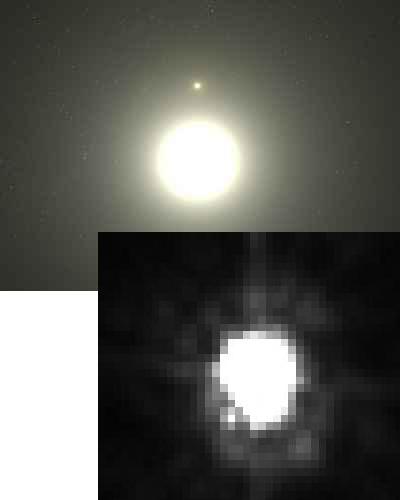The North Star is actually a system of three stars, and while one of the companions can be easily seen in small telescopes, the other star orbits Polaris so tightly that it has been impossible to see directly, until now.

Polaris, the North Star has two pale companions. Photo: Space Telescope Institute. In the bottom photo you see the hidden companion star at seven o'clock
We tend to think of Polaris, North Star, as a stable point in the sky that guided sailors in ancient times. However, there is much more to the North Star than what the eye sees - two pale stars that accompany it. The North Star is actually a system of three stars, and while one of the companions can be easily seen in small telescopes, the other star orbits Polaris so tightly that it was impossible to see directly, until now.
By stretching the capabilities of the Hubble Space Telescope to the limit, astronomers were able to photograph the close companion of the North Star for the first time. They presented their findings last week at a press conference as part of the 207th meeting of the American Astronomical Union.
"The star we observed is so close to the North Star that we needed every bit of Hubble's resolution to see it," says astronomer Nancy Evans of the Harvard-Smithsonian Center for Astrophysics.
The size of the companion star is less than twenty percent of the angular size of the North Star, an extremely small angle calculated for locating a 25 cent coin located at a distance of about 30 km. From a distance of 430 light years, this means a physical separation of about 3.3 billion km.
The difference in brightness between the two stars makes it more difficult to tell them apart, said Howard Bond of the Space Telescope Science Institute. Polaris is a giant super star two thousand times brighter than the Sun, while its companions are ordinary stars. With us we brought the companions of the North Star out of its shadow and into the spotlight.
By observing the movement of the companion stars, Evans and her colleagues were able to learn not only about the orbits of the stars but also about their masses. Measuring the mass of a star is one of the most difficult tasks facing stellar astronomers.
Astronomers want to determine the mass of the North Star precisely because it is the closest variable cupid. Cepheids are used to measure distances to galaxies and to measure the expansion rate of the universe, so it is essential to study their physics and evolution. Knowing their mass is one of the most important elements in this understanding.
Studying binary star systems is the only available way to measure the mass of stars, said team member Gail Schaeffer of the Space Telescope Science Institute. "We only have at our disposal the double stars that nature provided us" added Bond. "With the best instruments such as Hubble, we can look deeper into space and learn more about them up close."
The researchers plan to continue observing the North Star system for several years. At this time, the smaller companion will progress in its 30-year orbit around the North Star and then it will also be visible. "Our goal is to measure the exact mass of Polaris," Evans said. "To do this, the next milestone is to measure the motion of the companion in its orbit."
For information on the website of the Howard Smithsonian Institution
